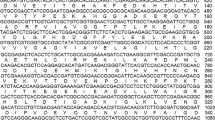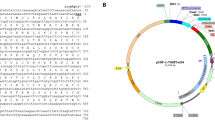Abstract
Glutathione reductases catalyze the reduction of oxidized glutathione (glutathione disulfide, GSSG) using NADPH as the substrate to produce reduced glutathione (GSH), which is an important antioxidant molecule that helps maintain the proper reducing environment of the cell. A recombinant form of glutathione reductase from Colwellia psychrerythraea, a marine psychrophilic bacterium, has been biochemically characterized to determine its molecular and enzymatic properties. C. psychrerythraea glutathione reductase was shown to be a homodimer with a molecular weight of 48.7 kDa using SDS-PAGE, MALDI-TOF mass spectrometry and gel filtration. The C. psychrerythraea glutathione reductase sequence shows significant homology to that of Escherichia coli glutathione reductase (66 % identity), and it possesses the FAD and NADPH binding motifs, as well as absorption spectrum features which are characteristic of flavoenzymes such as glutathione reductase. The psychrophilic C. psychrerythraea glutathione reductase exhibits higher k cat and k cat/K m at lower temperatures (4 °C) compared to mesophilic Baker’s yeast glutathione reductase. However, C. psychrerythraea glutathione reductase was able to complement an E. coli glutathione reductase deletion strain in oxidative stress growth assays, demonstrating the functionality of C. psychrerythraea glutathione reductase over a broad temperature range, which suggests its potential utility as an antioxidant enzyme in heterologous systems.





Similar content being viewed by others
Abbreviations
- C. psychrerythraea :
-
Colwellia psychrerythraea
- GR:
-
Glutathione reductase
- GSH:
-
Reduced glutathione
- GSSG:
-
Oxidized glutathione
References
Aghajari N, Feller G, Gerday C, Haser R (1998) Structures of the psychrophilic Alteromonas haloplanctis alpha-amylase give insights into cold adaptation at a molecular level. Structure 6:1503–1516
Barriere C, Centeno D, Lebert A, Leroy-Sétrin S, Berdague J, Talon R (2001) Roles of superoxide dismutase and catalase of Staphylococcus xylosus in the inhibition of linoleic acid oxidation. FEMS Microbiol Lett 201:181–185
Becker-Hapak M, Eisenstark A (1995) Role of rpoS in the regulation of glutathione oxidoreductase (gor) in Escherichia coli. FEMS Microbiol Lett 134:39–44
Bentahir M, Feller G, Aittaleb M, Lamotte-Brasseur J, Himri T, Chessa JP, Gerday C (2000) Structural, kinetic, and calorimetric characterization of the cold-active phosphoglycerate kinase from the antarctic Pseudomonas sp. TACII18. J Biol Chem 275:11147–11153
Bradford MM (1976) A rapid and sensitive method for the quantitation of microgram quantities of protein utilizing the principle of protein-dye binding. Anal Biochem 72:248–254
Carmel-Harel O, Storz G (2000) Roles of the glutathione-and thioredoxin-dependent reduction systems in the Escherichia coli and Saccharomyces cerevisiae responses to oxidative stress. Annu Rev Microbiol 54:439–461
Cavicchioli R, Siddiqui KS, Andrews D, Sowers KR (2002) Low-temperature extremophiles and their applications. Curr Opin Biotechnol 13:253–261
Colman RF, Black S (1965) On the role of flavin adenine dinucleotide and thiol groups in the catalytic mechanism of yeast glutathione reductase. J Biol Chem 240:1796–1803
Cooper WJ, Zika RG (1983) Photochemical Formation of hydrogen-peroxide in surface and ground waters exposed to sunlight. Science 220:711–712
D’Aoust JY, Kushner DJ (1972) Vibrio psychroerythrus sp. n.: classification of the psychrophilic marine bacterium, NRC 1004. J Bacteriol 111:340–342
Datsenko KA, Wanner BL (2000) One-step inactivation of chromosomal genes in Escherichia coli K-12 using PCR products. Proc Natl Acad Sci USA 97:6640–6645
Deming JW, Somers LK, Straube WL, Swartz DG, Macdonell MT (1988) Isolation of an abligately barophilic bacterium and description of a new genus, Colwellia GEN-NOV. Syst Appl Microbiol 10:152–160
Ding Y, Miao JL, Wang QF, Zheng Z, Li GY, Jian JC, Wu ZH (2007) Purification and characterization of a psychrophilic glutathione reductase from Antarctic ice microalgae Chlamydomonas sp Strain ICE-L. Polar Biol 31:23–30
Dym O, Eisenberg D (2001) Sequence-structure analysis of FAD-containing proteins. Protein Sci 10:1712–1728
Feller G (2013) Psychrophilic enzymes: from folding to function and biotechnology. Scientifica 2013:512840
Feller G, Gerday C (2003) Psychrophilic enzymes: hot topics in cold adaptation. Nat Rev Microbiol 1:200–208
Feller G, Le Bussy O, Gerday C (1998) Expression of psychrophilic genes in mesophilic hosts: assessment of the folding state of a recombinant α-amylase. Appl Environ Microbiol 64:1163–1165
Garcia-Alfonso C, Martinez-Galisteo E, Llobell A, Barcena JA, Lopez-Barea J (1993) Horse-liver glutathione reductase: purification and characterization. Int J Biochem 25:61–68
Grant CM, Dawes IW (1996) Synthesis and role of glutathione in protection against oxidative stress in yeast. Redox Rep 2:223–229
Grant CM, MacIver FH, Dawes IW (1996) Glutathione is an essential metabolite required for resistance to oxidative stress in the yeast Saccharomyces cerevisiae. Curr Genet 29:511–515
Halliwell B, Gutteridge JM (1984) Oxygen toxicity, oxygen radicals, transition metals and disease. Biochem J 219:1–14
Holmgren A (1976) Hydrogen donor system for Escherichia coli ribonucleoside-diphosphate reductase dependent upon glutathione. Proc Natl Acad Sci USA 73:2275–2279
Hopkins FG (1929) On glutathione: a reinvestigation. J Biol Chem 84:269–320
Huseby N-E, Sundkvist E, Svineng G (2009) Glutathione and sulfur containing amino acids: antioxidant and conjugation activities. In: Masella R, Mazza G Hoboken (eds) Glutathione and sulfur amino acids in human health and disease. Wiley. New Jersey, pp 93–120
Huston AL, Krieger-Brockett BB, Deming JW (2000) Remarkably low temperature optima for extracellular enzyme activity from Arctic bacteria and sea ice. Environ Microbiol 2:383–388
Jiang F, Hellman U, Sroga GE, Bergman B, Mannervik B (1995) Cloning, sequencing, and regulation of the glutathione reductase gene from the cyanobacterium Anabaena PCC 7120. J Biol Chem 270:22882–22889
Junge K, Imhoff F, Staley T, Deming JW (2002) Phylogenetic diversity of numerically important arctic sea-ice bacteria cultured at subzero temperature. Microbial Ecol 43:315–328
Kehrer JP, Lund LG (1994) Cellular reducing equivalents and oxidative stress. Free Radic Biol Med 17:65–75
Killens-Cade RR, Kitchener RL, Mathews SL, Schreck S, Ji ML, Turner R, MacInnes C, Grunden AM (2014) Production of extremophilic proteins using Escherichia coli-based expression systems. In: iConcept Press Ltd. (ed) Protein purification and analysis II methods and applications. iConcept Press Ltd., Hong Kong, pp 62–87
King MD, France JL, Fisher FN, Beine HJ (2005) Measurement and modelling of UV radiation penetration and photolysis rates of nitrate and hydrogen peroxide in Antarctic sea ice: an estimate of the production rate of hydroxyl radicals in first-year sea ice. J Photoch Photobiol A 176:39–49
Kosower NS, Kosower EM (1978) The glutathione status of cells. Int Rev Cytol 54:109–160
Kosower NS, Kosower EM (1995) Diamide: an oxidant probe for thiols. Methods Enzymol 251:123–133
Kunert KJ, Cresswell CF, Schmidt A, Mullineaux PM, Foyer CH (1990) Variations in the activity of glutathione reductase and the cellular glutathione content in relation to sensitivity to methylviologen in Escherichia coli. Arch Biochem Biophys 282:233–238
Libreros-Minotta CA, Pardo JP, Mendoza-Hernandez G, Rendon JL (1992) Purification and characterization of glutathione reductase from Rhodospirillum rubrum. Arch Biochem Biophys 298:247–253
Lomaestro BM, Malone M (1995) Glutathione in health and disease: pharmacotherapeutic issues. Ann Pharmacother 29:1263–1273
Lonhienne T, Zoidakis J, Vorgias CE, Feller G, Gerday C, Bouriotis V (2001) Modular structure, local flexibility and cold-activity of a novel chitobiase from a psychrophilic Antarctic bacterium. J Mol Biol 310:291–297
Lopez-Barea J, Lee CY (1979) Mouse-liver glutathione reductase. Purification, kinetics, and regulation. Eur J Biochem 98:487–499
Loprasert S, Whangsuk W, Sallabhan R, Mongkolsuk S (2005) The unique glutathione reductase from Xanthomonas campestris: gene expression and enzyme characterization. Biochem Biophys Res Commun 331:1324–1330
Lushchak VI (2001) Oxidative stress and mechanisms of protection against it in bacteria. Biochemistry 66:476–489
Macheroux P (1999) UV-visible spectroscopy as a tool to study flavoproteins. Methods Mol Biol 131:1–7
Massey V, Williams CH Jr (1965) On the reaction mechanism of yeast glutathione reductase. J Biol Chem 240:4470–4480
Mavis RD, Stellwagen E (1968) Purification and subunit structure of glutathione reductase from bakers’ yeast. J Biol Chem 243:809–814
McMinn A, Pankowski A, Delfatti T (2005) Effect of hyperoxia on the growth and photosynthesis of polar sea ice microalgae. J Phycol 41:732–741
Meister A, Anderson ME (1983) Glutathione. Annu Rev Biochem 52:711–760
Methe BA, Nelson KE, Deming JW, Momen B, Melamud E, Zhang X, Moult J, Madupu R, Nelson WC, Dodson RJ, Brinkac LM, Daugherty SC, Durkin AS, DeBoy RT, Kolonay JF, Sullivan SA, Zhou L, Davidsen TM, Wu M, Huston AL, Lewis M, Weaver B, Weidman JF, Khouri H, Utterback TR, Feldblyum TV, Fraser CM (2005) The psychrophilic lifestyle as revealed by the genome sequence of Colwellia psychrerythraea 34H through genomic and proteomic analyses. Proc Natl Acad Sci USA 102:10913–10918
Mock T, Thomas DN (2005) Recent advances in sea-ice microbiology. Environ Microbiol 7:605–619
Neftel A, Jacob P, Klockow D (1984) Measurements of hydrogen-peroxide in polar ice samples. Nature 311:43–45
Oikawa T, Yamamoto N, Shimoke K, Uesato S, Ikeuchi T, Fujioka T (2005) Purification, characterization, and overexpression of psychrophilic and thermolabile malate dehydrogenase of a novel antarctic psychrotolerant, Flavobacterium frigidimaris KUC-1. Biosci Biotechnol Biochem 69:2146–2154
Perry AC, Ni Bhriain N, Brown NL, Rouch DA (1991) Molecular characterization of the gor gene encoding glutathione reductase from Pseudomonas aeruginosa: determinants of substrate specificity among pyridine nucleotide-disulphide oxidoreductases. Mol Microbiol 5:163–171
Pocsi I, Miskei M, Karanyi Z, Emri T, Ayoubi P, Pusztahelyi T, Balla G, Prade RA (2005) Comparison of gene expression signatures of diamide, H2O2 and menadione exposed Aspergillus nidulans cultures–linking genome-wide transcriptional changes to cellular physiology. BMC Genom 6:182
Rendón JL, Calcagno M, Mendoza-Hernández G, Ondarza RN (1986) Purification, properties, and oligomeric structure of glutathione reductase from the cyanobacterium Spirulina maxima. Arch Biochem Biophysics 248:215–223
Rescigno M, Perham RN (1994) Structure of the NADPH-binding motif of glutathione reductase: efficiency determined by evolution. Biochemistry 33:5721–5727
Ritz D, Beckwith J (2001) Roles of thiol-redox pathways in bacteria. Annual Rev Microbiol 55:21–48
Scrutton NS, Berry A, Perham RN (1987) Purification and characterization of glutathione reductase encoded by a cloned and over-expressed gene in Escherichia coli. Biochem J 245:875–880
Scrutton NS, Berry A, Perham RN (1990) Redesign of the coenzyme specificity of a dehydrogenase by protein engineering. Nature 343:38–43
Thomas DN, Dieckmann GS (2002) Antarctic Sea ice–a habitat for extremophiles. Science 295:641–644
Tuggle CK, Fuchs JA (1985) Glutathione reductase is not required for maintenance of reduced glutathione in Escherichia coli K-12. J Bacteriol 162:448–450
Yamamoto Y, Kamio Y, Higuchi M (1999) Cloning, nucleotide sequence, and disruption of Streptococcus mutans glutathione reductase gene (gor). Biosci Biotechnol Biochem 63:1056–1062
Yamanaka Y, Kazuoka T, Yoshida M, Yamanaka K, Oikawa T, Soda K (2002) Thermostable aldehyde dehydrogenase from psychrophile, Cytophaga sp. KUC-1: enzymological characteristics and functional properties. Biochem Biophys Res Commun 298:632–637
Yu BP (1994) Cellular defenses against damage from reactive oxygen species. Physiol Rev 74:139–162
Acknowledgments
Support for this study was provided by NASA’s Institute for Advanced Concepts (NIAC) and by the North Carolina Agriculture Research Station. The authors would like to thank Jason Whitham and Dr. Sherry Tove for assistance in editing the manuscript and Janet Kim for help with statistical analysis.
Author information
Authors and Affiliations
Corresponding author
Additional information
Communicated by H. Atomi.
Electronic supplementary material
Below is the link to the electronic supplementary material.
Rights and permissions
About this article
Cite this article
Ji, M., Barnwell, C.V. & Grunden, A.M. Characterization of recombinant glutathione reductase from the psychrophilic Antarctic bacterium Colwellia psychrerythraea . Extremophiles 19, 863–874 (2015). https://doi.org/10.1007/s00792-015-0762-1
Received:
Accepted:
Published:
Issue Date:
DOI: https://doi.org/10.1007/s00792-015-0762-1




